-
Paper Information
- Next Paper
- Previous Paper
- Paper Submission
-
Journal Information
- About This Journal
- Editorial Board
- Current Issue
- Archive
- Author Guidelines
- Contact Us
American Journal of Environmental Engineering
p-ISSN: 2166-4633 e-ISSN: 2166-465X
2016; 6(4A): 66-73
doi:10.5923/s.ajee.201601.10

Evolution and Synoptic Environment of the 4 July 2014 Supercells in Southern Brazil
Maurício I. Oliveira, Eliton L. Figueiredo, Vanessa Ferreira, Murilo M. Lopes, Ernani L. Nascimento
Grupo de Modelagem Atmosferica, Universidade Federal de Santa Maria, Santa Maria, Brazil
Correspondence to: Ernani L. Nascimento, Grupo de Modelagem Atmosferica, Universidade Federal de Santa Maria, Santa Maria, Brazil.
| Email: |  |
Copyright © 2016 Scientific & Academic Publishing. All Rights Reserved.
This work is licensed under the Creative Commons Attribution International License (CC BY).
http://creativecommons.org/licenses/by/4.0/

An analysis of severe convective storms that occurred in the evening of 4 July 2014 in extreme southern Brazil is presented. Doppler radar data showed that a few storms displayed supercell characteristics, such as motion to the left of the mean wind, weak echo region in the reflectivity field, and cyclonic rotation. The severe storms evolved in conditionally unstable air mass with above-normal moisture content considering wintertime conditions. The general synoptic environment consisted of a 500-hPa migratory trough crossing the Andes and associated upper-level jet stream, promoting intense deep-layer vertical wind shear over southern Brazil. At the surface, a deepening inverted trough was observed over the La Plata Basin. This feature became the focus for convective initiation and played a role in strengthening the low-level northwesterly flow, characterizing a low level jet stream that extended over southern Brazil. In such environment storms rapidly became severe given the combination of moderate conditional instability and strong directional wind shear at low levels.
Keywords: Severe convective storms, Supercells, Damaging winds, Natural hazards, Southern Brazil
Cite this paper: Maurício I. Oliveira, Eliton L. Figueiredo, Vanessa Ferreira, Murilo M. Lopes, Ernani L. Nascimento, Evolution and Synoptic Environment of the 4 July 2014 Supercells in Southern Brazil, American Journal of Environmental Engineering, Vol. 6 No. 4A, 2016, pp. 66-73. doi: 10.5923/s.ajee.201601.10.
Article Outline
1. Introduction
- A severe convective storm is defined as one that produces large hail, and/or damaging straight-line winds, and/or tornadoes [1]. A special class of severe convective storm, the supercell, is characterized by displaying a persistent, deep, rotating updraft (i.e., a mesocyclone; [2]) and is capable of producing a myriad of severe weather hazards ([3], [4]).Several studies have shown that the subtropics of South America, east of the Andes mountain range, host some of the most intense convective storms worldwide (e.g. [5], [6], [7], [8]), including supercell storms [9].To illustrate the social and economic impact of severe local storms in southern Brazil, Figure 1 shows statistics of hazard reports compiled by the Secretaries of Civil Defense of Rio Grande do Sul (hereafter referred to as RS) and Santa Catarina states in southern Brazil for the period between 2003 and 2011. Considering only report of hazards associated with the occurrence of large hail and damaging winds, nearly one-quarter of the events was related to severe storms, which is a substantial figure. Despite that, only a few studies address the detailed evolution of severe storms and their atmospheric environment in Brazil (e.g., [10] [9]).
2. Data and Methodology
- Different data sources were utilized in the analysis of the convective cells and of the atmospheric environment in which they developed. Hourly data from automated weather stations (AWS) from the Brazil´s National Meteorological Institute (INMET; acronym in portuguese) were employed to characterize the evolution of surface atmospheric conditions in RS state around the time of the strongest convective cells. On a larger scale, SYNOP observations over the La Plata Basin were also analyzed. The vertical atmospheric profile observed at 00:00Z 5 July 2014 (9 PM 4 July 2014 in local standard time (LST)) was investigated using upper air data from the operational sounding from Santa Maria Air Force Base (SBSM), located in central RS (Figure 2b). The profile was not contaminated by the ongoing convection in RS and, thus, the sounding sampled the general characteristics of the air mass in which the storms evolved, satisfying criteria established by [5] for a proximity sounding.
3. Results
3.1. Radar Data Analysis of Storm Evolution
- Convective initiation was observed as early as 15:00Z 4 July 2014 over extreme northeastern Argentina with storms displaying prevailing motion to the southeast, as inferred by the (few) GOES-13 thermal-infrared and visible images available for that day (not shown). By 18:00Z storms had already crossed the Brazil-Argentina border into far western RS. (Deep convection also developed over eastern sections of RS during the afternoon hours, but the convective cells associated with most significant severe weather reports were the ones in western and southwestern RS).From mid to late afternoon, scattered convective storms embedded in a northwesterly synoptic flow passed tens of km southwest of SNTG radar. Figure 3 shows a time sequence PPIs for 0.5° elevation scans for base reflectivity from SNTG radar from 19:20Z to 22:50Z at 30-min intervals, as the storms passed to the southwest, south and southeast of the radar site. During this period, three cells became particularly strong and displayed motion to the left of the mean wind. These convective cells are tracked and labeled in Figure 3.
3.2. Synoptic and Mesoscale Environments
- GOES-13 water vapor image loops from 12:00Z 4 July to 00:00Z 5 July (not shown) and CSFv2 analysis at 00:00Z 5 July (Figure 5a) showed a migratory upper-level trough over the Andes Cordillera and its associated NW-SE oriented jet stream extending from northern Chile to the southwestern Atlantic Ocean. The state of RS was far downstream of the upper-level trough and, in the CSFv2 analysis, RS was to the east and to the north of 200 hPa jet streaks (Figure 5a). The corresponding 00:00Z SBSM sounding depicted in Figure 6 confirmed the strong westerly [northwesterly] flow in the upper [middle] troposphere over central RS, such that the CFSv2 data was, at least locally, in good agreement with the upper level observations.
4. Conclusions
- Severe convective storms in extreme southern Brazil and their atmospheric environment were examined in this study. Storm evolution was investigated using Doppler radar data. This (austral) wintertime severe weather episode occurred during the evening and night hours of 4 July 2014 in SW-central portions of Rio Grande do Sul state.The storms initiated over northeastern Argentina earlier in the afternoon in a conditionally unstable atmosphere along a NW-SE-oriented inverted trough that extended to southwestern RS. As storms moved southeastwards into southern Brazil some of them experienced rapid intensification and motion to the left of the mean tropospheric flow. Wind damage was reported at night with one such cell in the rural sections of the town of Rosário do Sul in midwestern RS. One of the left-moving storms displayed a WER along with a long-lived cyclonic couplet in the radial velocity field characterizing a supercell storm.As for the synoptic environment, the mid-to-upper level westerly flow was strong over the extreme south of Brazil in response to a 500 hPa migratory trough. This configuration generated intense deep-layer vertical wind shear in the region. In the lower troposphere, the deepening of the inverted trough induced a strong northwesterly LLJS that advected warm and moist air into southwestern RS, destabilizing the atmosphere. Combined with northeasterly surface winds observed over RS, the LLJS also produced significant directional vertical wind shear and storm-relative helicity at low-levels, as confirmed by the SBSM sounding. The combination of moisture availability with a conditionally unstable air mass, strong surface convergence, intense deep layer wind shear, the presence of a LLJS, and directional low-level wind shear explained the formation of severe storms including at least one long-lived supercell.One relevant aspect of the 4 July 2014 event is that it took place in a moisture-rich environment during winter. This episode exemplifies a wintertime condition in southern Brazil in which a baroclinic environment, with strong vertical wind shear, gives rise to severe local storms during the occasional lower-tropospheric incursion of warm moist air. Forecasters in that region should be aware of these instances when predicting convective storms.It is also important to stress the role played by the surface (inverted) trough extending from northeastern Argentina to southern Brazil in creating the environment conducive to severe convection in the eastern portions of the La Plata Basin. The deepening of the trough promotes not only low-level convergence and moisture pooling, but also an isallobaric response in the wind field that generates or intensifies the northerly lower-tropospheric flow, most often characterizing a LLJS. Sometimes, as was the case in the 4 July 2014 event, the surface winds to the east of the trough responds to such deepening with a northeasterly component, which increases the directional vertical wind shear at low levels. The aforementioned synoptic configuration develops without the presence of an extratropical cyclone necessarily.
ACKNOWLEDGEMENTS
- We would like to thank the Environmental Satellite Division from Brazil´s National Space Research Institute (DSA-INPE), and in particular meteorologist Thiago Biscaro, for making available the raw radar data used in this study.
 Abstract
Abstract Reference
Reference Full-Text PDF
Full-Text PDF Full-text HTML
Full-text HTML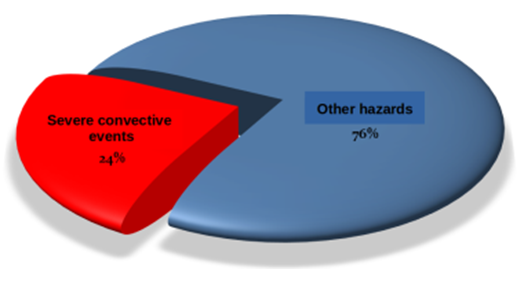
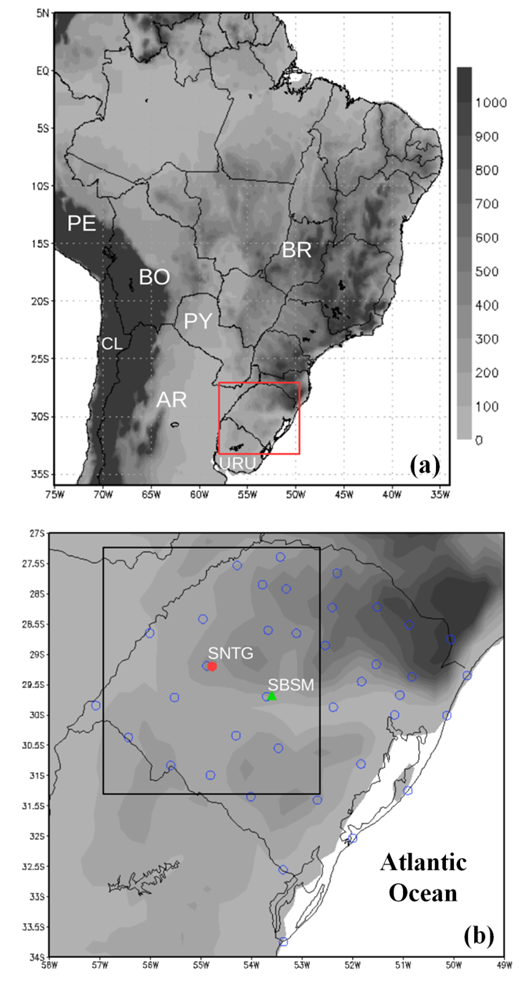


 ; green and purple: inbound; red: outbound). The black arrow in (b) highlights the velocity couplet. (Data source: DECEA and DSA-INPE)
; green and purple: inbound; red: outbound). The black arrow in (b) highlights the velocity couplet. (Data source: DECEA and DSA-INPE)
 ; blue barbs), and magnitude of the 200-hPa winds (shading; in
; blue barbs), and magnitude of the 200-hPa winds (shading; in  ); (b) sea-level pressure (coloured isobars; in hPa), and precipitable water (blue shading; in mm). Location of Rio Grande do Sul state (RS) is indicated in all panelsAt the surface (Figure 5b), a Northwest Argentinean Low [16] pressure system extended meridionally along the Andes foothills, being, to a large extent, a response to the migratory upper-level trough [16]. Additionally, from northeastern Argentina to the Brazil-Uruguay border, an inverted trough with NW-SE orientation was in place. This feature was confirmed by SYNOP observations over the La Plata basin at the same time (not shown). The extension of the inverted trough towards southern Brazil indicates the role played by quasi-geostrophic forcing by the upper-level cyclonic system in lowering surface pressure and (low-tropospheric) geopotential heights further downstream from the Andes. This is a rather common synoptic evolution observed during severe weather conditions in southern Brazil [17].
); (b) sea-level pressure (coloured isobars; in hPa), and precipitable water (blue shading; in mm). Location of Rio Grande do Sul state (RS) is indicated in all panelsAt the surface (Figure 5b), a Northwest Argentinean Low [16] pressure system extended meridionally along the Andes foothills, being, to a large extent, a response to the migratory upper-level trough [16]. Additionally, from northeastern Argentina to the Brazil-Uruguay border, an inverted trough with NW-SE orientation was in place. This feature was confirmed by SYNOP observations over the La Plata basin at the same time (not shown). The extension of the inverted trough towards southern Brazil indicates the role played by quasi-geostrophic forcing by the upper-level cyclonic system in lowering surface pressure and (low-tropospheric) geopotential heights further downstream from the Andes. This is a rather common synoptic evolution observed during severe weather conditions in southern Brazil [17]. 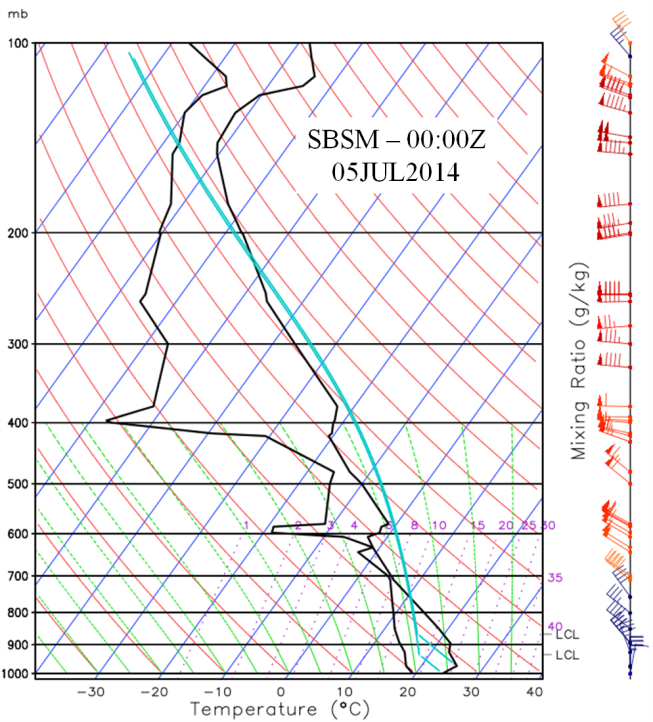

 ; black barbs), and wind magnitude (shading; in
; black barbs), and wind magnitude (shading; in  )
)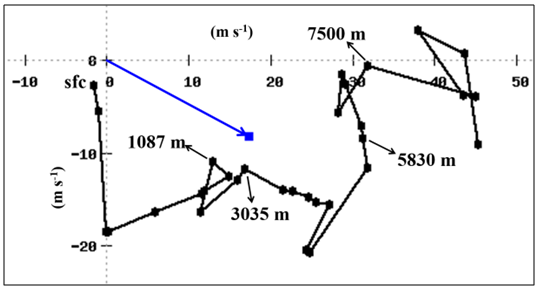

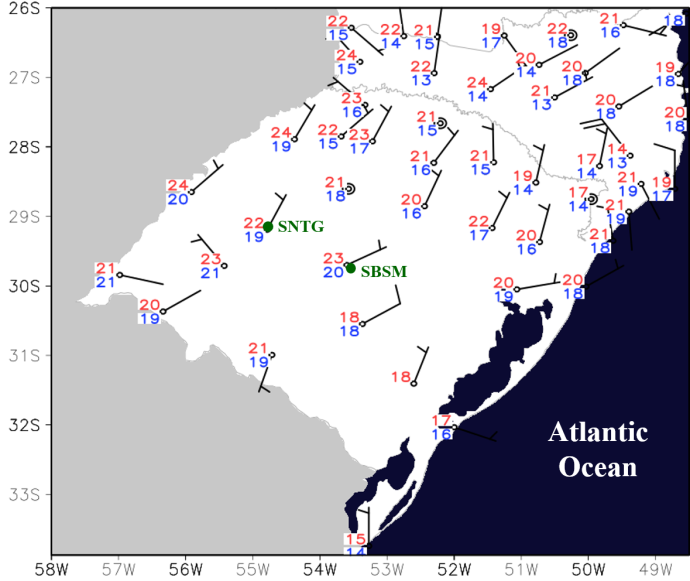
 ). Location of SNTG radar and SBSM sounding site are superimposed in green. Source: INMET
). Location of SNTG radar and SBSM sounding site are superimposed in green. Source: INMET